Abstract
Fourteen strains of Escherichia coli were tested for ability to cause infective endocarditis in rabbits prepared by prior placement of an intracardiac catheter. Strains that were resistant to the bactericidal action of serum caused E. coli endocarditis in 91.4% of rabbits, whereas serum-sensitive strains usually failed to cause persisting infection (11.3% infected, P less than 0.001). Although serum-sensitive E. coli lodged on heart valves within 1 h after intravenous injection, they survived less than 24 h in most normal rabbits. In contrast to normals, all five C6-deficient rabbits injected with a serum-sensitive strain of E. coli developed infective endocarditis (P less than 0.005). No correlation was found between the presence of K1 antigen and the incidence of experimental E. coli endocarditis. Thus, the ability of strains of E. coli to establish persisting endocardial infection in rabbits appears to be directly associated with resistance to the complement-mediated serum bactericidal system. These findings may explain in part the rarity of gram-negative bacillary endocarditis in patients; they also indicate that in certain special circumstances the serum bactericidal system can play a decisive role in host defense.
Full text
PDF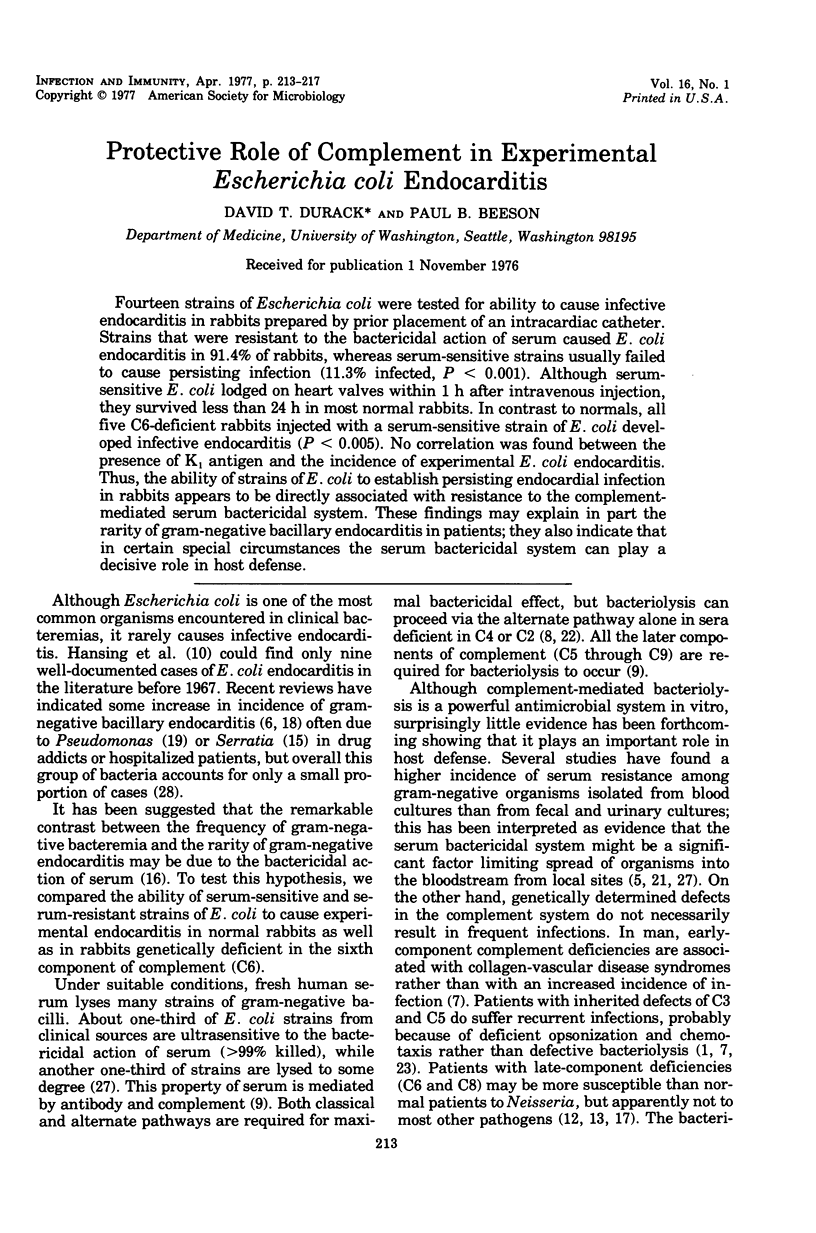
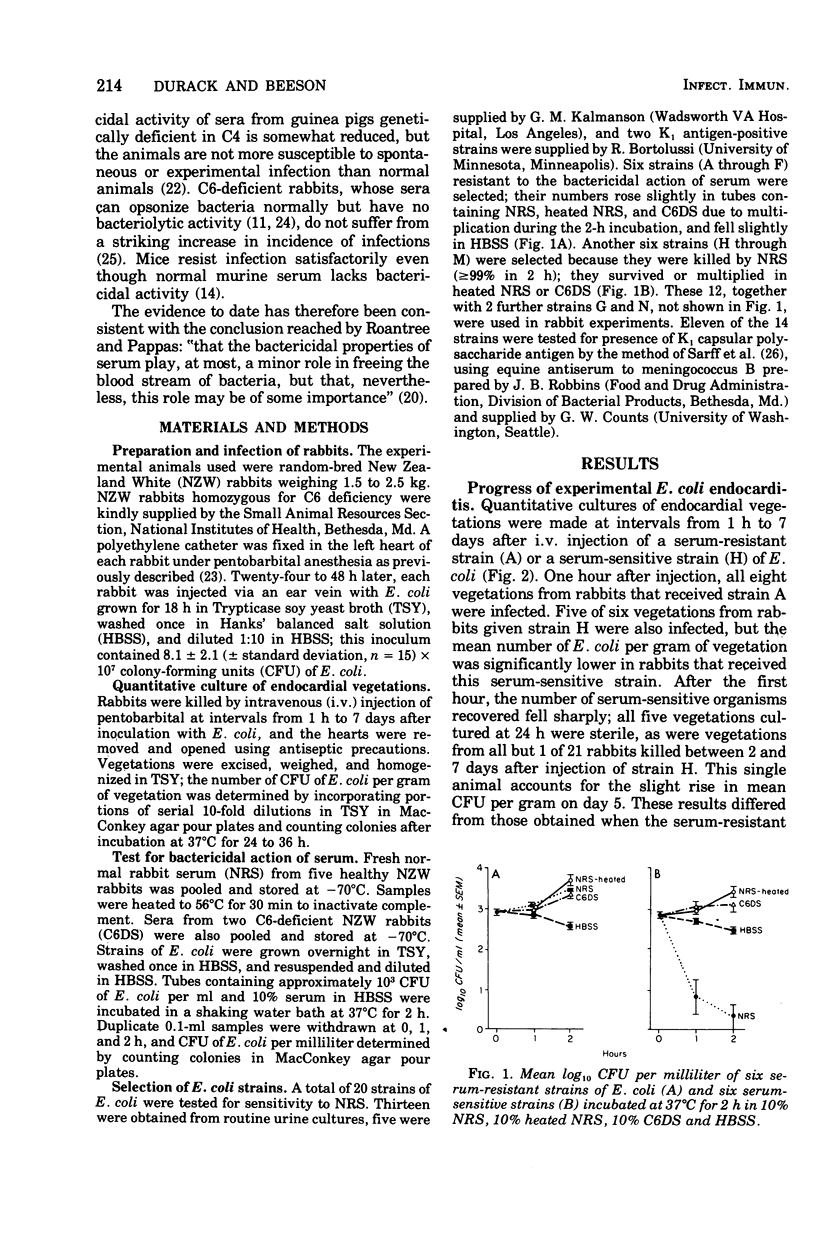
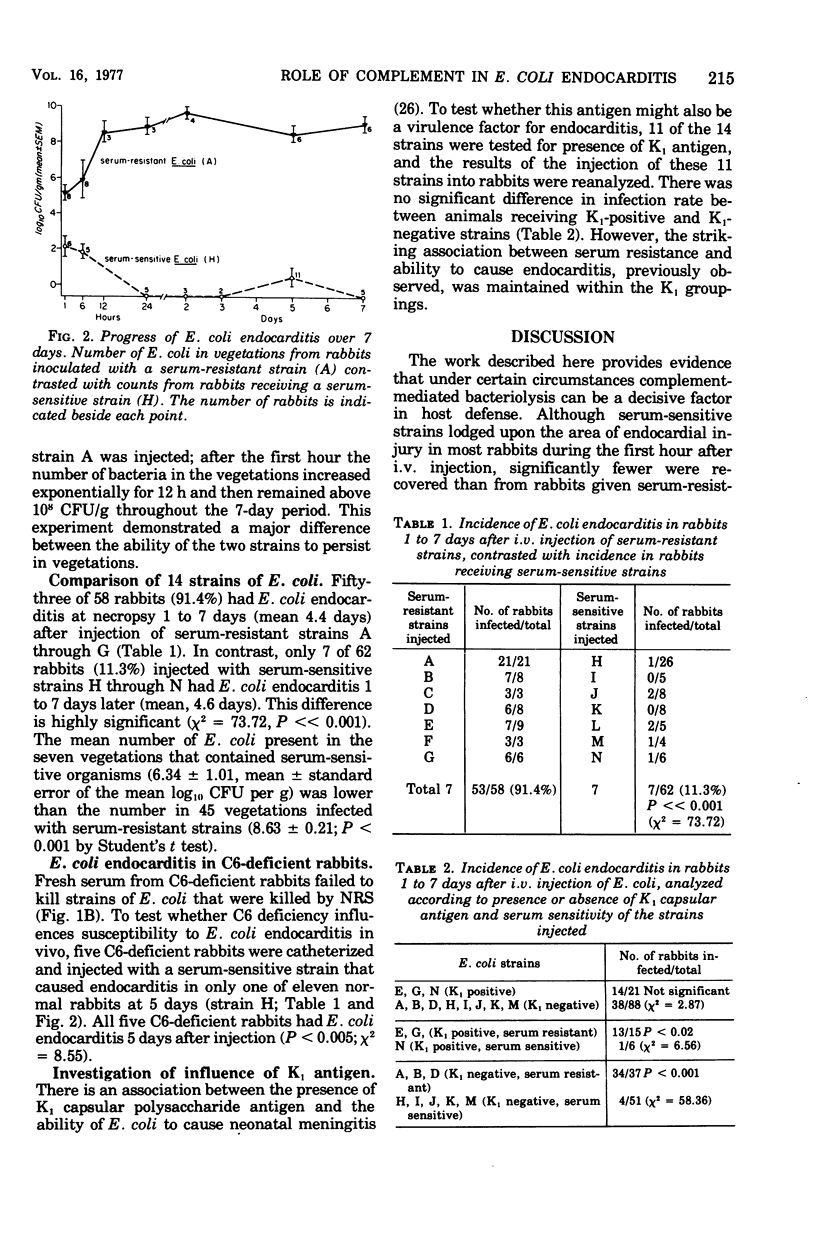
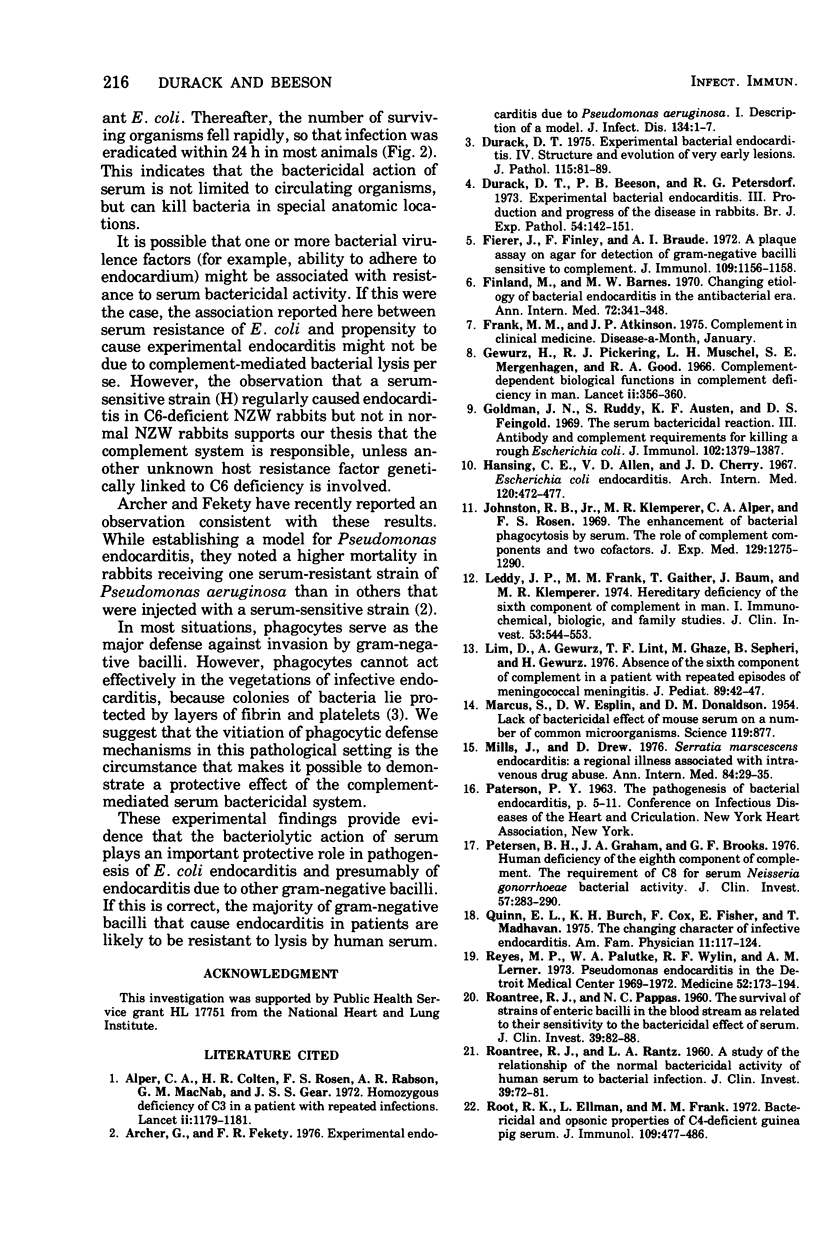
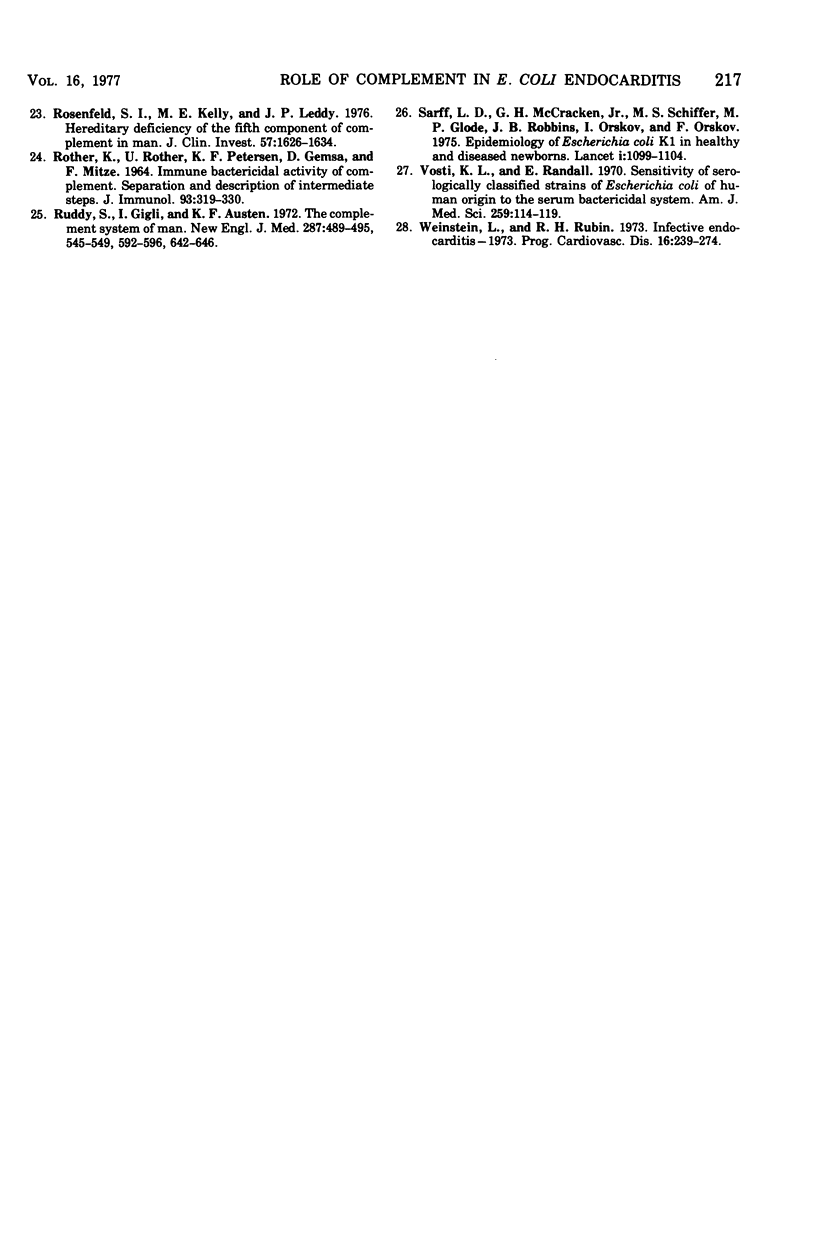
Selected References
These references are in PubMed. This may not be the complete list of references from this article.
- Alper C. A., Colten H. R., Rosen F. S., Rabson A. R., Macnab G. M., Gear J. S. Homozygous deficiency of C3 in a patient with repeated infections. Lancet. 1972 Dec 2;2(7788):1179–1181. doi: 10.1016/s0140-6736(72)92598-6. [DOI] [PubMed] [Google Scholar]
- Archer G., Fekety F. R. Experimental endocarditis due to Pseudomonas aeruginosa. I. Description of a model. J Infect Dis. 1976 Jul;134(1):1–7. doi: 10.1093/infdis/134.1.1. [DOI] [PubMed] [Google Scholar]
- Durack D. T., Beeson P. B., Petersdorf R. G. Experimental bacterial endocarditis. 3. Production and progress of the disease in rabbits. Br J Exp Pathol. 1973 Apr;54(2):142–151. [PMC free article] [PubMed] [Google Scholar]
- Durack D. T. Experimental bacterial endocarditis. IV. Structure and evolution of very early lesions. J Pathol. 1975 Feb;115(2):81–89. doi: 10.1002/path.1711150204. [DOI] [PubMed] [Google Scholar]
- Fierer J., Finley F., Braude A. I. A plaque assay on agar for detection of gram-negative bacilli sensitive to complement. J Immunol. 1972 Nov;109(5):1156–1158. [PubMed] [Google Scholar]
- Finland M., Barnes M. W. Changing etiology of bacterial endocarditis in the antibacterial era. Experiences at Boston City Hospital 1933-1965. Ann Intern Med. 1970 Mar;72(3):341–348. doi: 10.7326/0003-4819-72-3-341. [DOI] [PubMed] [Google Scholar]
- Gewurz H., Pickering R. J., Muschel L. H., Mergenhagen S. E., Good R. A. Complement-dependent biological functions in complement deficiency in man. Lancet. 1966 Aug 13;2(7459):356–360. doi: 10.1016/s0140-6736(66)92658-4. [DOI] [PubMed] [Google Scholar]
- Goldman J. N., Ruddy S., Austen K. F., Feingold D. S. The serum bactericidal reaction. 3. Antibody and complement requirements for killing a rough Escherichia coli. J Immunol. 1969 Jun;102(6):1379–1387. [PubMed] [Google Scholar]
- Hansing C. E., Allen V. D., Cherry J. D. Escherichia coli endocarditis. A review of the literature and a case study. Arch Intern Med. 1967 Oct;120(4):472–477. doi: 10.1001/archinte.120.4.472. [DOI] [PubMed] [Google Scholar]
- Johnston R. B., Jr, Klemperer M. R., Alper C. A., Rosen F. S. The enhancement of bacterial phagocytosis by serum. The role of complement components and two cofactors. J Exp Med. 1969 Jun 1;129(6):1275–1290. doi: 10.1084/jem.129.6.1275. [DOI] [PMC free article] [PubMed] [Google Scholar]
- Leddy J. P., Frank M. M., Gaither T., Baum J., Klemperer M. R. Hereditary deficiency of the sixth component of complement in man. I. Immunochemical, biologic, and family studies. J Clin Invest. 1974 Feb;53(2):544–553. doi: 10.1172/JCI107588. [DOI] [PMC free article] [PubMed] [Google Scholar]
- Lim D., Gewurz A., Lint T. F., Ghaze M., Sepheri B., Gewurz H. Absence of the sixth component of complement in a patient with repeated episodes of meningococcal meningitis. J Pediatr. 1976 Jul;89(1):42–47. doi: 10.1016/s0022-3476(76)80924-9. [DOI] [PubMed] [Google Scholar]
- MARCUS S., ESPLIN D. W., DONALDSON D. M. Lack of bactericidal effect of mouse serum on a number of common microorganisms. Science. 1954 Jun 18;119(3103):877–877. doi: 10.1126/science.119.3103.877. [DOI] [PubMed] [Google Scholar]
- Mills J., Drew D. Serratia marcescens endocarditis: a regional illness associated with intravenous drug abuse. Ann Intern Med. 1976 Jan;84(1):29–35. doi: 10.7326/0003-4819-84-1-29. [DOI] [PubMed] [Google Scholar]
- Petersen B. H., Graham J. A., Brooks G. F. Human deficiency of the eighth component of complement. The requirement of C8 for serum Neisseria gonorrhoeae bactericidal activity. J Clin Invest. 1976 Feb;57(2):283–290. doi: 10.1172/JCI108279. [DOI] [PMC free article] [PubMed] [Google Scholar]
- Quinn E. L., Burch K. H., Cox F., Fisher E., Madhavan T. The changing character of infective endocarditis. Am Fam Physician. 1975 Mar;11(3):117–124. [PubMed] [Google Scholar]
- ROANTREE R. J., PAPPAS N. C. The survival of strains of enteric bacilli in the blood stream as related to their sensitivity to the bactericidal effect of serum. J Clin Invest. 1960 Jan;39:82–88. doi: 10.1172/JCI104031. [DOI] [PMC free article] [PubMed] [Google Scholar]
- ROTHER K., ROTHER U., PETERSEN K. F., GEMSA D., MITZE F. IMMUNE BACTERICIDAL ACTIVITY OF COMPLEMENT. SEPARATION AND DESCRIPTION OF INTERMEDIATE STEPS. J Immunol. 1964 Aug;93:319–330. [PubMed] [Google Scholar]
- Roantree R. J., Rantz L. A. A STUDY OF THE RELATIONSHIP OF THE NORMAL BACTERICIDAL ACTIVITY OF HUMAN SERUM TO BACTERIAL INFECTION. J Clin Invest. 1960 Jan;39(1):72–81. doi: 10.1172/JCI104029. [DOI] [PMC free article] [PubMed] [Google Scholar]
- Root R. K., Ellman L., Frank M. M. Bactericidal and opsonic properties of C4-deficient guinea pig serum. J Immunol. 1972 Sep;109(3):477–486. [PubMed] [Google Scholar]
- Rosenfeld S. I., Kelly M. E., Leddy J. P. Hereditary deficiency of the fifth component of complement in man. I. Clinical, immunochemical, and family studies. J Clin Invest. 1976 Jun;57(6):1626–1634. doi: 10.1172/JCI108433. [DOI] [PMC free article] [PubMed] [Google Scholar]
- Ruddy S., Gigli I., Austen K. F. The complement system of man. I. N Engl J Med. 1972 Sep 7;287(10):489–495. doi: 10.1056/NEJM197209072871005. [DOI] [PubMed] [Google Scholar]
- Sarff L. D., McCracken G. H., Schiffer M. S., Glode M. P., Robbins J. B., Orskov I., Orskov F. Epidemiology of Escherichia coli K1 in healthy and diseased newborns. Lancet. 1975 May 17;1(7916):1099–1104. doi: 10.1016/s0140-6736(75)92496-4. [DOI] [PubMed] [Google Scholar]
- Vosti K. L., Randall E. Sensitivity of serologically classified strains of escherichia coli of human origin to the serum bactericidal system. Am J Med Sci. 1970 Feb;259(2):114–119. doi: 10.1097/00000441-197002000-00005. [DOI] [PubMed] [Google Scholar]
- Weinstein L., Rubin R. H. Infective endocarditis--1973. Prog Cardiovasc Dis. 1973 Nov-Dec;16(3):239–274. doi: 10.1016/s0033-0620(73)80001-5. [DOI] [PubMed] [Google Scholar]


